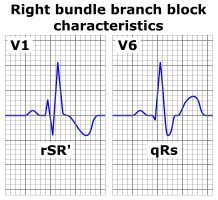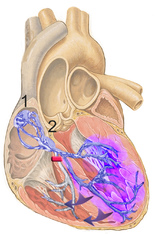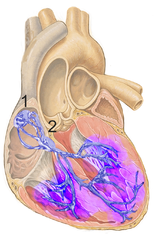Right Bundle Branch Block
Q:
Hi i
I am a 37 female, went to the ER an I got a EKG done can u please tell me if this is anything to worry???
Sinus rhythym with short PR
Left atrial enlargement
Rightward axis
Right bundle block
abnormal EKG.
Q:
Why did you go to the ER? Enlargement of the left atrium of the heart can be caused by a myriad of different disorders that include high blood pressure, obesity or a valve problem to name a few. This is why you need to talk to the doctor who gave you the test, so that he can interpret the results in context with other findings.
Your ECG in a Bundle Branch Block:
In this figure, the top image shows a normal QRS complex. The middle figure shows RBBB, and the bottom figure shows LBBB. Note that with both kinds of bundle branch block, the QRS is wide and misshapen. The characteristic shapes of the QRS complex allow doctors to determine whether the right or the left bundle branch is blocked. Why does the QRS complex change in BBB? The QRS represents the spread of the heart’s electrical impulse across the right and left ventricles. Because with BBB the ventricles receive the electrical impulse one after another instead of at the same time, it takes longer to form the QRS complex on the ECG. The QRS complex is said to “widen.” Also, since the pattern of the spreading of the electrical impulse is abnormal in BBB, the pattern of the QRS complex is also abnormal.
Here, once again is what is is seen on EKG:
 ECG characteristics of a typical RBBB showing wide QRS complexes with a terminal R wave in lead V1 and slurred S wave in lead V6.
ECG characteristics of a typical RBBB showing wide QRS complexes with a terminal R wave in lead V1 and slurred S wave in lead V6.
Normal electrical conduction system of the heart). All myocardial segments are excited almost simultaneously (purple staining).
1. Sinoatrial node
2. Atrioventricular node.
Conduction in RBBB: With a blockage in the right bundle branch (red), the left ventricle is excited in time (purple), while the excitation of the right ventricle takes a detour via the left bundle branch (blue arrows).
BBB is quite common, and occurs in a variety of medical conditions. RBBB occurs in medical conditions that affect the right side of the heart or the lungs, so a finding of RBBB on the ECG ought to trigger a screening exam for such conditions. These include blood clots to the lung (pulmonary embolus), chronic lung disease, cardiomyopathy, and atrial and ventricular septal defects. However, RBBB also commonly occurs in normal, healthy individuals, and the screening exam therefore often turns up no medical problems. In these cases, the RBBB has no apparent medical significance, and can be written off as a “normal variant,” and safely ignored.
Hope this helps,
Dr T
http://www.cardiac-risk-assessment.com/
(From: The Significance of Bundle Branch Block, Richard N. Fogoros, M.D, 2003)




